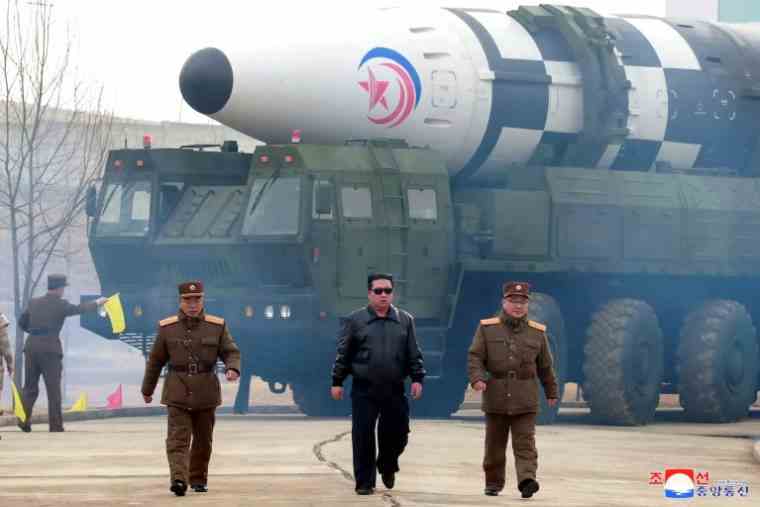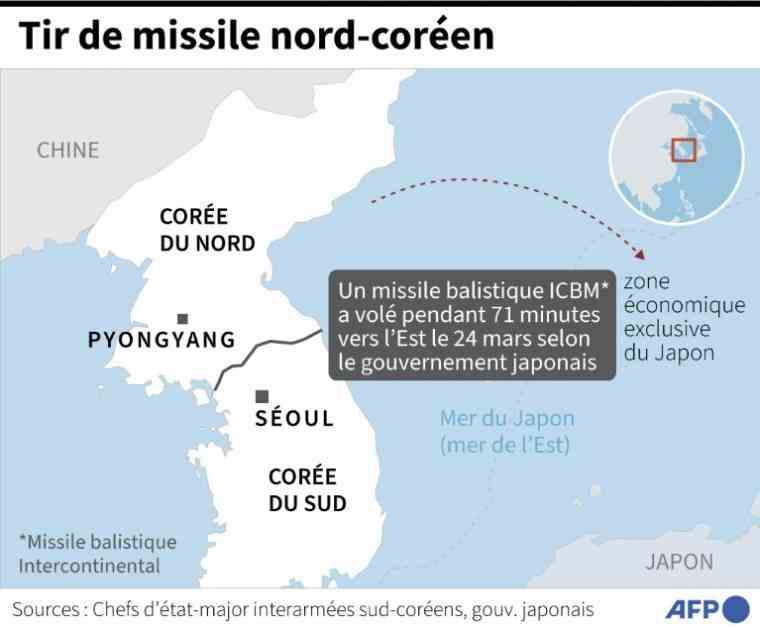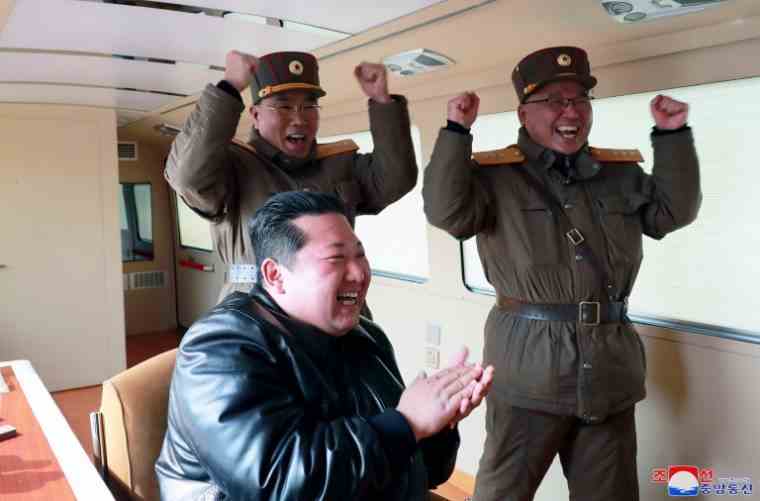Photo released on March 25, 2022 by North Korean agency Kcna of a Hwasong-17 intercontinental ballistic missile being fired at an unspecified location in North Korea on March 24, 2022 (KCNA VIA KNS/STR)
North Korean leader Kim Jong Un personally ordered and supervised the firing of the country’s most powerful intercontinental ballistic missile (ICBM), ensuring that Pyongyang is ready for a “long-winded confrontation” with the United States, reports the state news agency on Friday.
A meeting of the Security Council will be held Friday from 3:00 p.m. (7:00 p.m. GMT), according to the UN and diplomats.
North Korea on Thursday launched, for the first time since 2017, a “full-range” missile that flew higher and farther than any previous ICBM tested by the nuclear-armed country.
Named Hwasong-17, the missile, which is capable of hitting any part of US territory, landed in Japan’s Exclusive Economic Maritime Zone.
“The missile, launched from Pyongyang International Airport, reached a maximum altitude of 6,248.5 km and traveled a distance of 1,090 km for 4,052 seconds before accurately hitting the predefined area,” KCNA said.
Photos taken by state media show the leader, dressed in his usual black leather jacket and dark sunglasses, walking on the tarmac in front of a huge missile.
On others, he cheers and celebrates the shot with uniformed high-ranking brass.
The new ICBM will make “the whole world aware (…) of the power of our strategic armed forces”, Kim Jong Un said, according to KCNA, adding that the country is now “ready for a long-term confrontation with the American imperialists”.

Photo released on March 25, 2022 by North Korean news agency Kcna of North Korean leader Kim Jong Un (c) in front of a Hwasong-17 intercontinental ballistic missile at an unspecified location in North Korea, March 24, 2022 ( KCNA VIA KNS/STR)
The Hwasong-17, first unveiled in October 2020, is dubbed a “monster missile” by analysts. It had never been successfully tested before, and the launch brought new US sanctions.
This is “a break from the moratorium on the launch of intercontinental ballistic missiles to which President Kim Jong Un” had committed in 2017, lamented the President of South Korea, Moon Jae-in.
– Risk of escalation –
US Secretary of State Antony Blinken spoke to South Korean Foreign Minister Chung Eui-yong on Thursday evening, saying the shooting “demonstrates the threat that illegal weapons of mass destruction and ballistic missile programs of the DPRK pose a burden on its neighbors and on the entire international community,” according to State Department spokesman Ned Price.

North Korean missile launch (AFP/)
The South Korean military said it responded by firing “missiles from the ground, sea and air” off its coast.
The United Nations, through the voice of the spokesman for Secretary General Antonio Guterres, “condemned” Thursday “strongly” this shooting.
“The launch of a long-range missile runs the risk of a significant escalation of tensions in the region,” said Stéphane Dujarric, spokesman for the secretary general.
UN resolutions prohibit North Korea, hit by heavy international sanctions for its nuclear and weapons programs, from testing ballistic missiles.
This has not prevented Pyongyang from carrying out a dozen tests of this type of weaponry since the start of the year.

Photo released on March 25, 2022 by North Korea’s Kcna news agency of North Korean leader Kim Jong Un (c) applauding during a Hwasong-17 intercontinental ballistic missile launch at an unspecified location in North Korea on March 24, 2022. (KCNA THROUGH KNS/STR)
But it was not until now intercontinental missiles, even if Washington and Seoul suspect the North Korean regime of having tested certain ICBM systems during these launches.
Pyongyang carried out three ICBM launches in 2017. The device then tested, the Hwasong-15, was able to reach the United States.
– Failed last week –
According to Seoul, a missile test by North Korea on March 16 ended in failure, with the projectile exploding in the sky above Pyongyang shortly after launch. The regime has kept silent about this event.

Data on North Korea’s missile arsenal (AFP/)
Analysts had expected Pyongyang, which will celebrate the 110th birth anniversary of Kim Il Sung, the country’s founder and grandfather of Kim Jong Un, on April 15, to put on a show of force to mark the most important on the North Korean political calendar.
Kim Jong Un said last year that improving the country’s military capabilities was a priority for the regime.
Priority among priorities: developing an ICBM capable of carrying several conventional or nuclear warheads each following an independent trajectory, difficult to intercept by anti-missile systems.
“Kim probably feels that now is the perfect time to develop ICBMs, and to remind the world emphatically that the North, unlike Ukraine, is a nuclear-armed country,” he told Reuters. AFP Ahn Chan-il, North Korea expert.
“What is important with (Hwasong-17) is not how far it can travel, but what it can potentially carry, i.e. multiple warheads,” said the analyst Ankit Panda at AFP, which North Korea has coveted for a long time.

